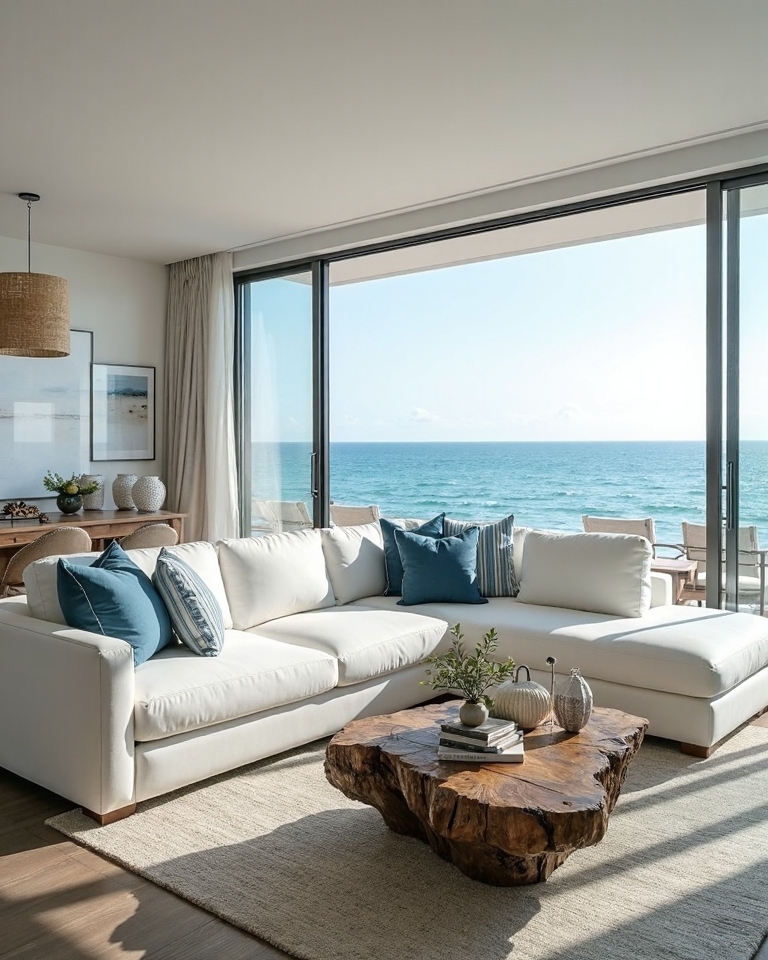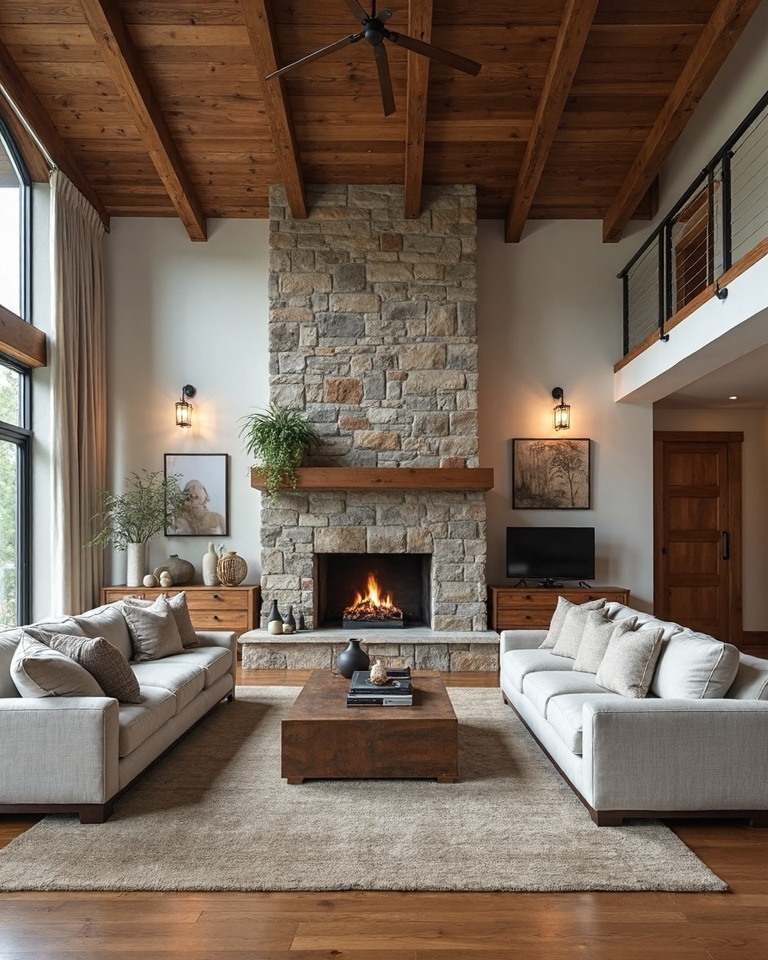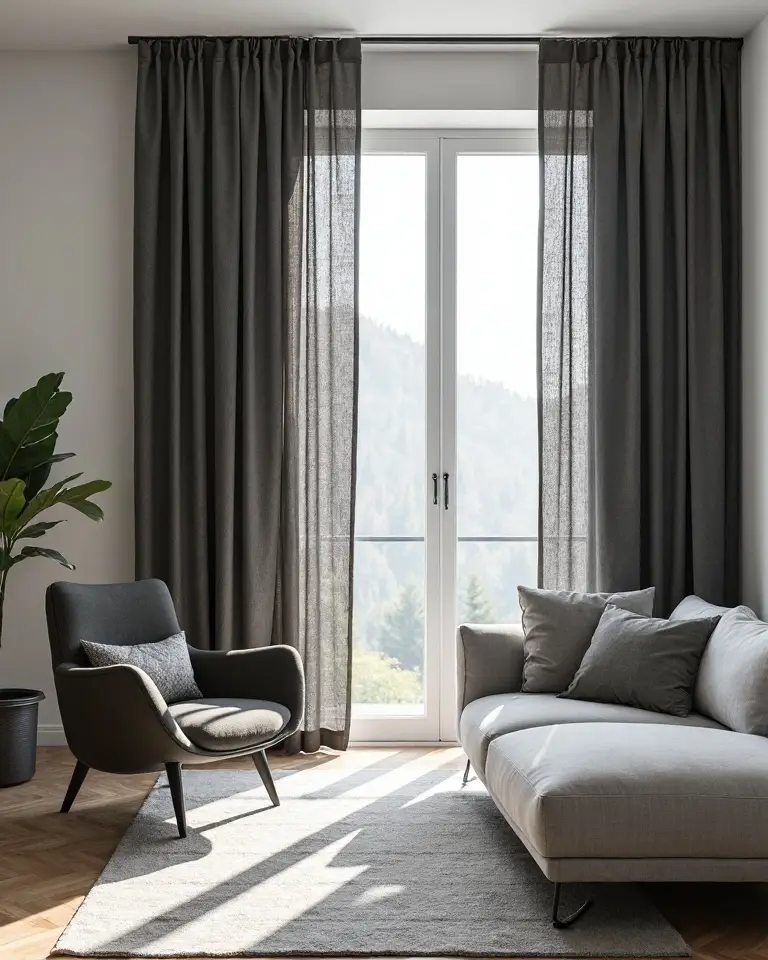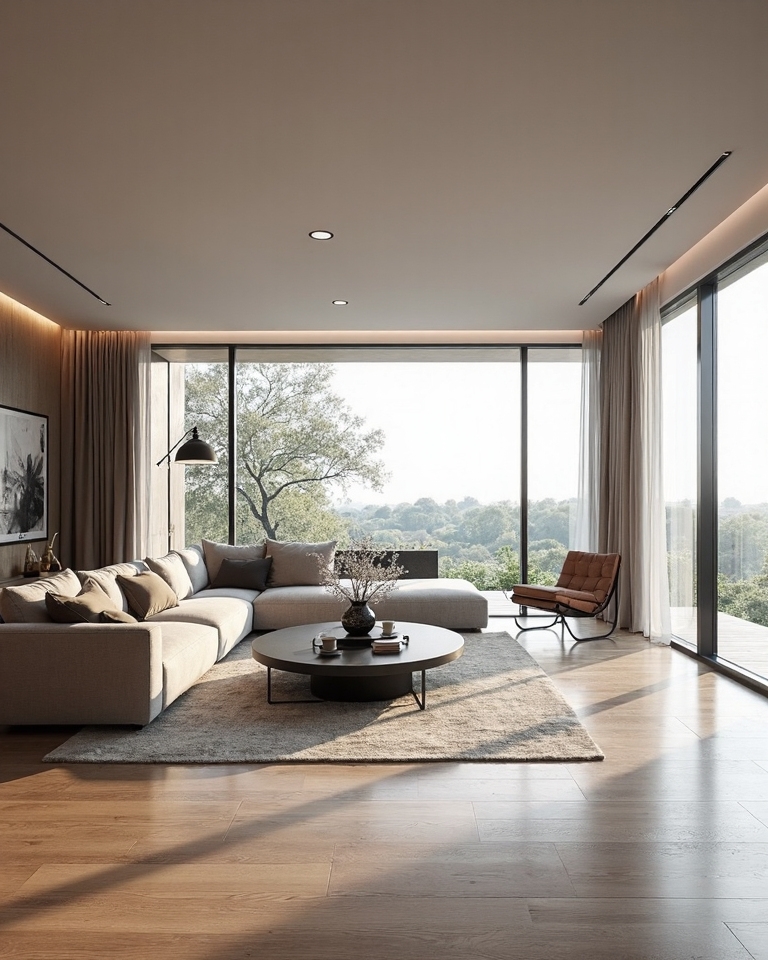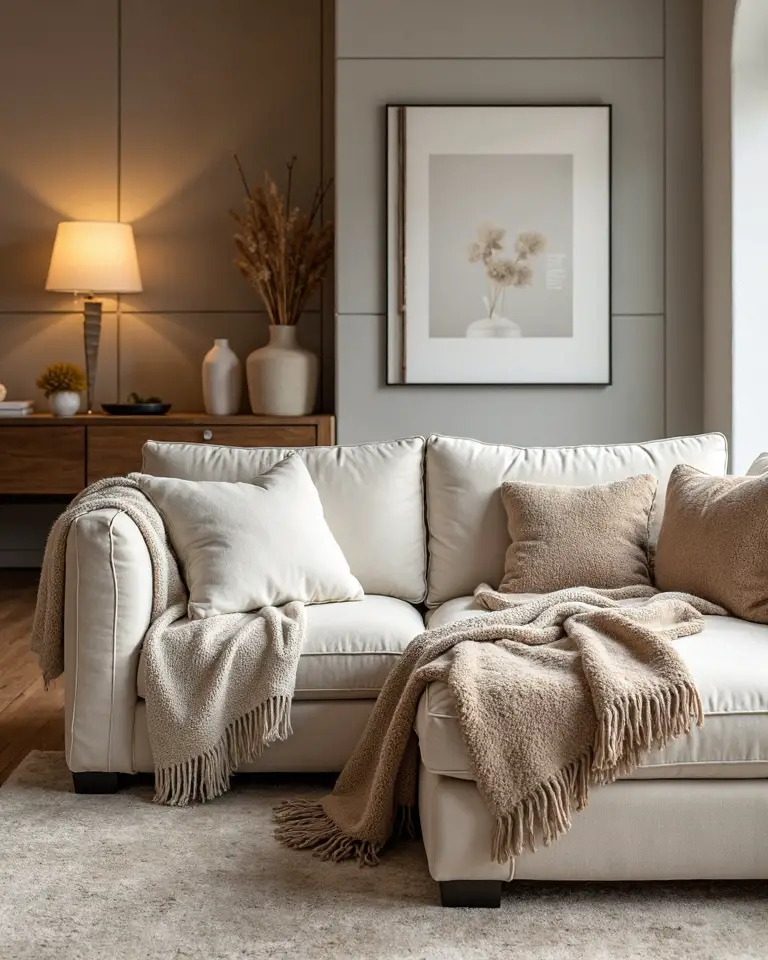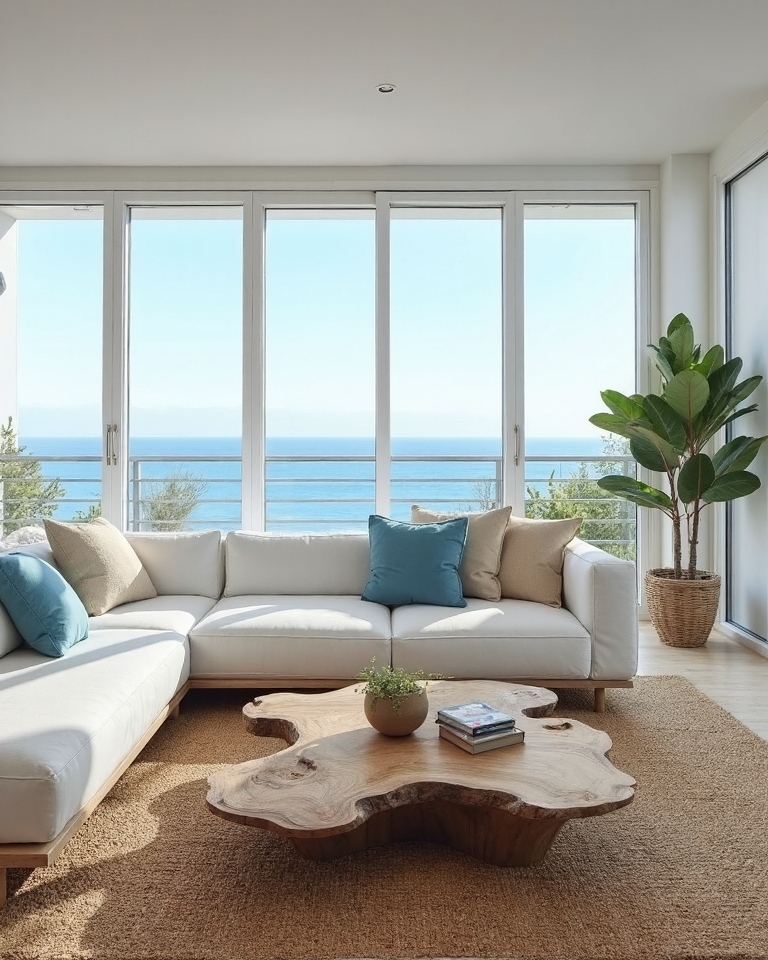22 Relaxing Modern Japandi Living Room Ideas for Minimalist Peace and Beauty
Harmonize your space with these 22 Japandi living room designs that blend Japanese serenity with Scandinavian simplicity for ultimate tranquility.
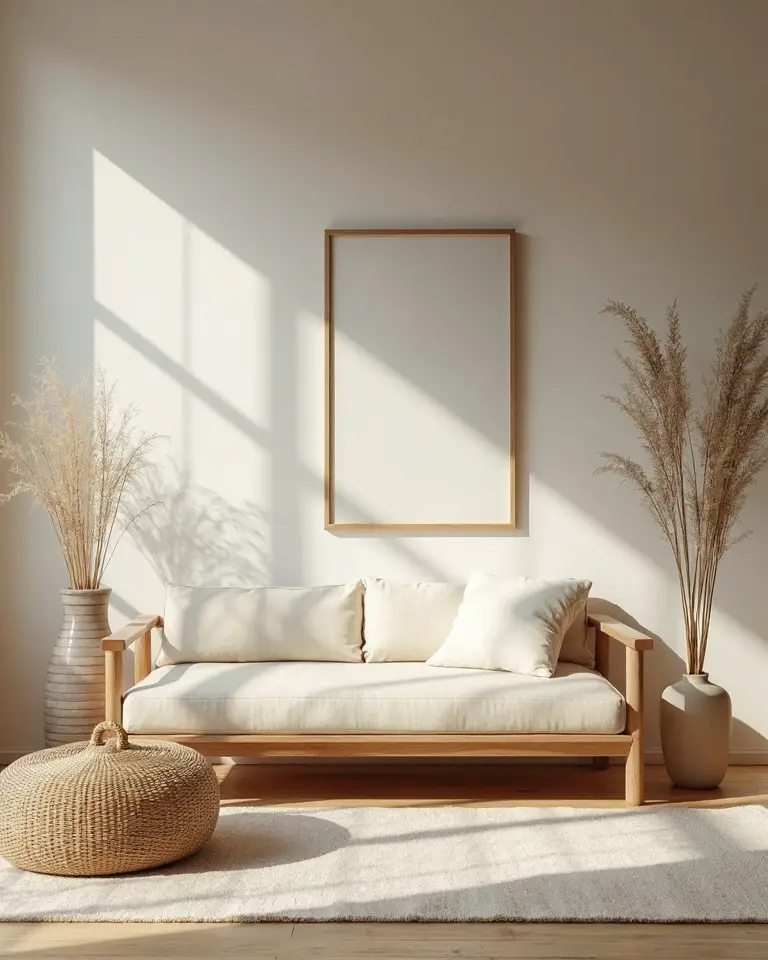
You’ll uncover how Japandi design metamorphoses your living room into a peaceful sanctuary where Japanese wabi-sabi meets Scandinavian minimalism. This aesthetic combines natural wood elements, soft linen textures, and carefully curated lighting to create spaces that promote genuine relaxation. By embracing imperfection and simplicity, you can craft a room that feels both sophisticated and deeply calming. The key lies in understanding how specific materials, colors, and arrangements work together to achieve this coveted balance of…
Natural Wood Statement Wall With Integrated Lighting
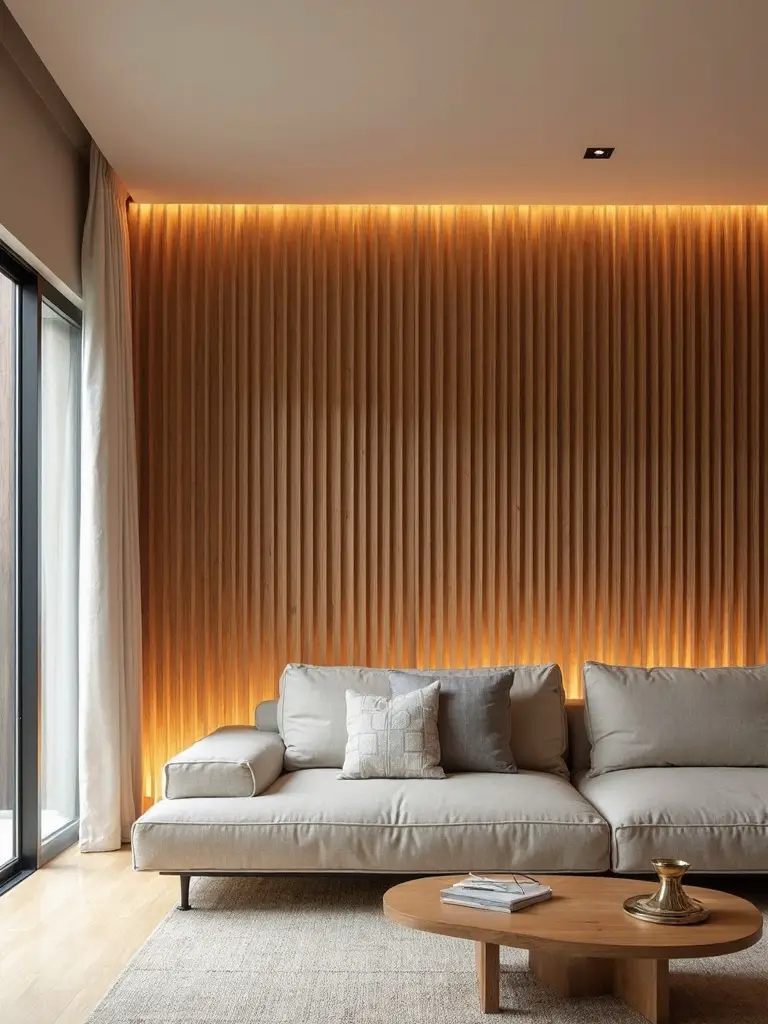
How can you create a stunning focal point that captures the essence of Japandi design while adding warmth to your living room? Install a natural wood slat feature wall using light oak or ash planks arranged vertically for organic texture.
This minimalist aesthetic perfectly embodies Japanese Wabi-Sabi philosophy while maintaining Scandinavian clean lines. Integrate hidden LED strips within the slats for ambient lighting that enhances the wood’s natural grain patterns.
The statement wall creates depth and visual interest while pairing beautifully with neutral furniture, allowing the natural material’s beauty to shine in your calming space.
Low-Profile Floor Seating Arrangement
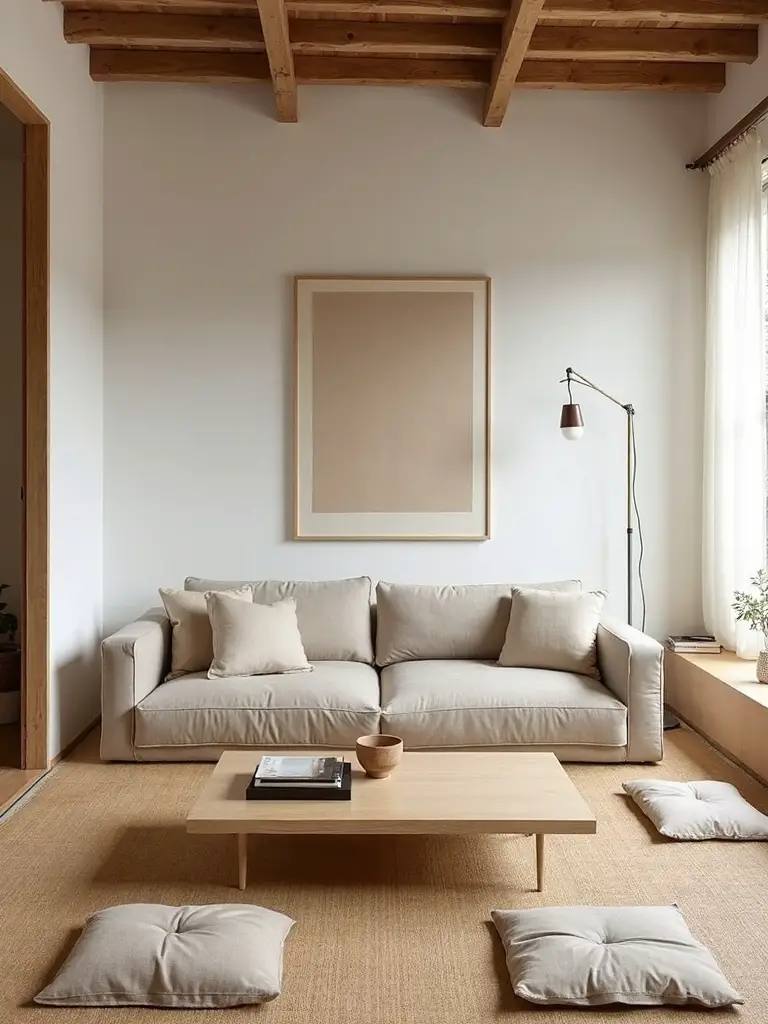
Several thoughtfully arranged floor-level seating elements can modify your living room into a serene, contemplative space that perfectly embodies Japandi principles. Choose a low-profile sectional sofa paired with traditional Japanese zabuton meditation cushions for authentic comfort.
Natural fiber fabrics like linen and hemp create that essential grounding feel while supporting the minimalist aesthetic. Position your solid wood coffee table strategically to maintain uninterrupted sightlines throughout the space. This Scandinavian-influenced arrangement promotes openness and tranquility.
Complete your floor-based seating area with adjustable task lighting and a tactile area rug that ties together this inviting, contemplative environment.
Neutral Color Foundation With Warm Undertones
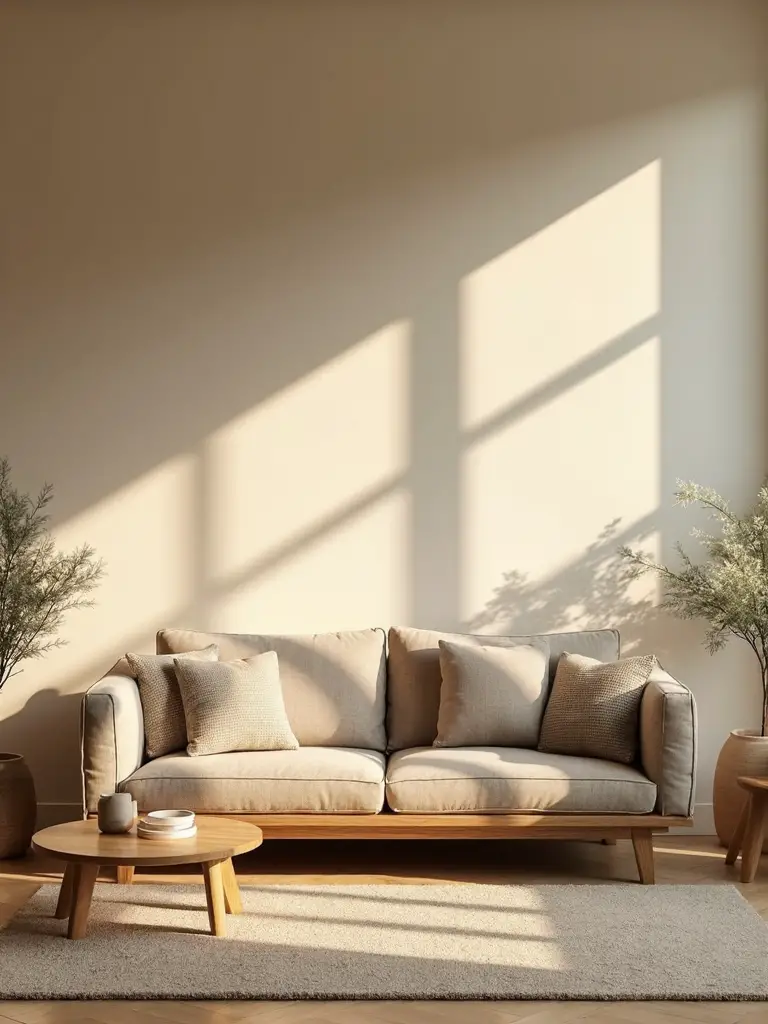
Establishing a neutral color palette with subtle warm undertones forms the visual backbone of successful Japandi design, creating that coveted sense of calm and balance. You’ll want to build your foundation using soft whites, gentle grays, and creamy beiges as your primary neutral tones.
These colors work beautifully when paired with earthy tones like warm taupe, mushroom gray, or soft sand. The key is selecting hues that feel naturally weathered rather than stark or cold. This thoughtful approach to your neutral color palette guarantees your living room maintains that serene, spa-like atmosphere essential to authentic Japandi style.
Minimalist Paper Lantern Lighting Design
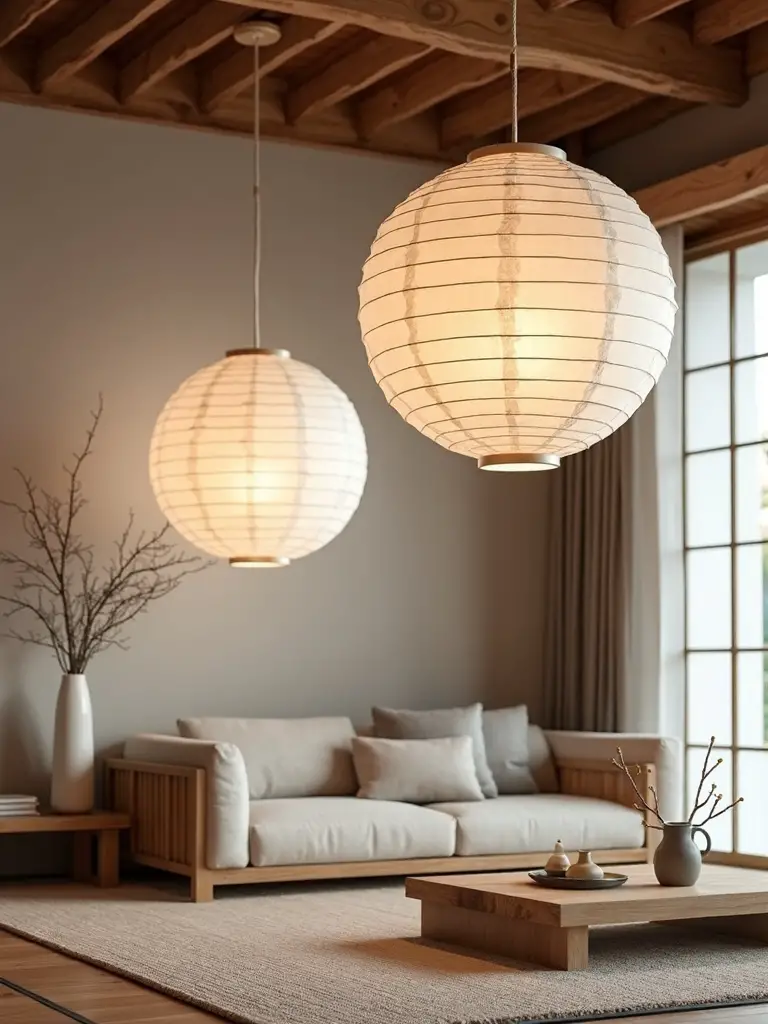
When thoughtfully integrated into your Japandi living room, minimalist paper lantern lighting creates an ethereal glow that perfectly bridges Japanese serenity with Scandinavian functionality. Choose contemporary paper lanterns in neutral whites, beiges, or soft grays to maintain your minimalist design principles while adding visual warmth.
Layer different heights with pendant lanterns over seating areas, floor lamps in corners, and table versions on side surfaces. Install dimmable controls to adjust brightness from intimate evening moods to bright daytime functionality.
These natural materials complement wood furniture and rattan accents, creating cohesive lighting that enhances your space’s tranquil, nature-inspired atmosphere.
Natural Fiber Textures and Woven Materials
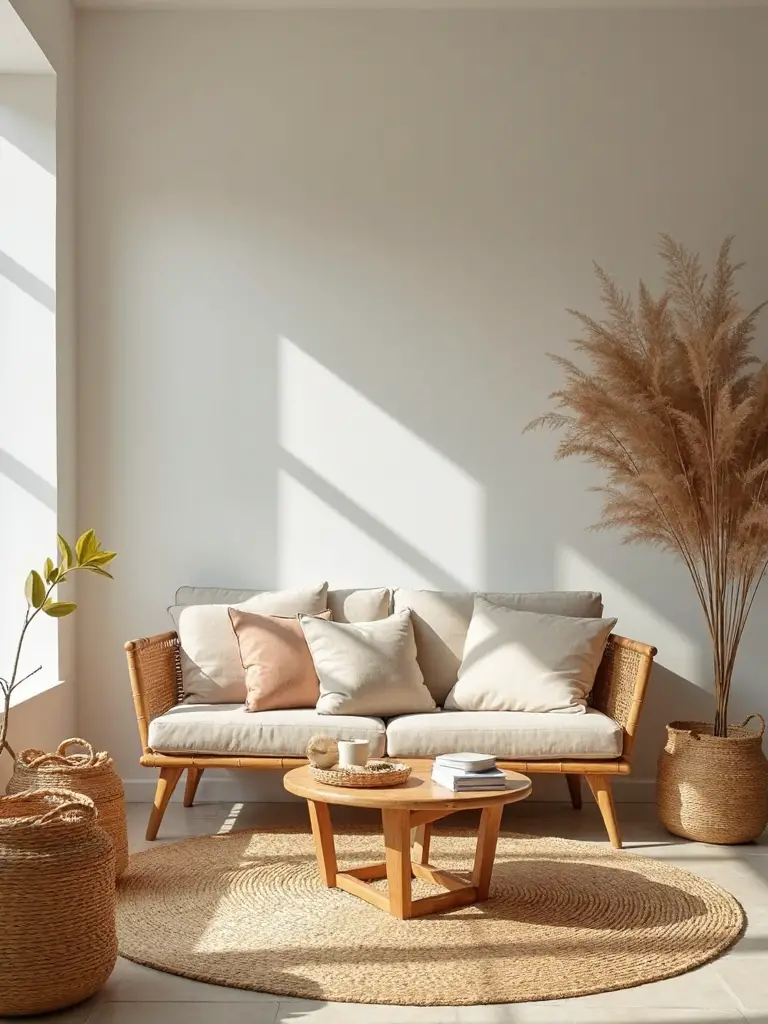
Beyond lighting, natural fiber textures and woven elements form the tactile foundation that makes your Japandi living room feel both sophisticated and inviting. Layer chunky knit throws and pillows in cream or beige across your seating to create immediate warmth.
Choose rattan chairs or wicker storage baskets that balance minimalism with organic materials. Install bamboo window coverings that filter harsh light while maintaining privacy.
Add jute rugs beneath coffee tables for grounding natural textures. Hang woven wall art or display decorative baskets on floating shelves to introduce depth without cluttering your serene space.
Scandinavian-Japanese Fusion Furniture Pieces
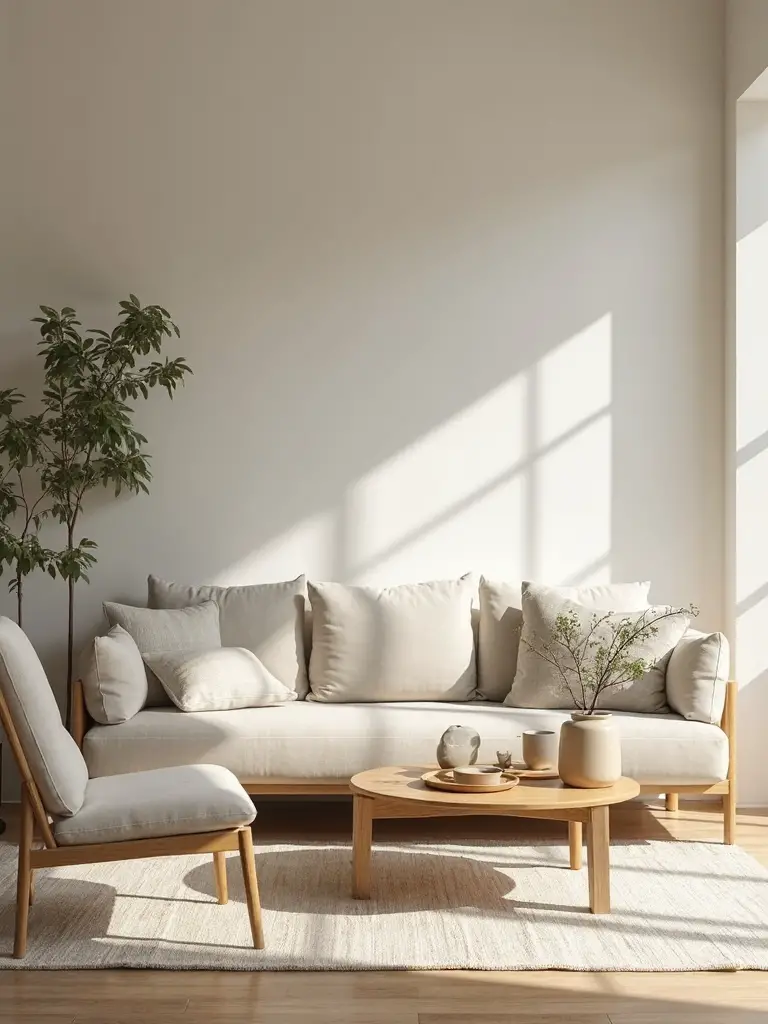
The perfect marriage of Scandinavian functionality and Japanese minimalism creates furniture pieces that alter your living room into a serene retreat. You’ll uncover low-profile modular sofas and floor cushions that encourage grounded, relaxed seating experiences.
Choose solid wood coffee tables showcasing artisanal craftsmanship through simple forms using natural materials like oak or walnut. Curved armchairs with angled wooden frames blend organic Japanese shapes with Scandinavian comfort. Built-in cabinetry and multifunctional ottomans provide hidden storage while maintaining clean lines and minimalist silhouettes.
These thoughtfully designed pieces prioritize uncluttered surfaces that promote tranquility throughout your space.
Indoor Plant Integration for Biophilic Connection
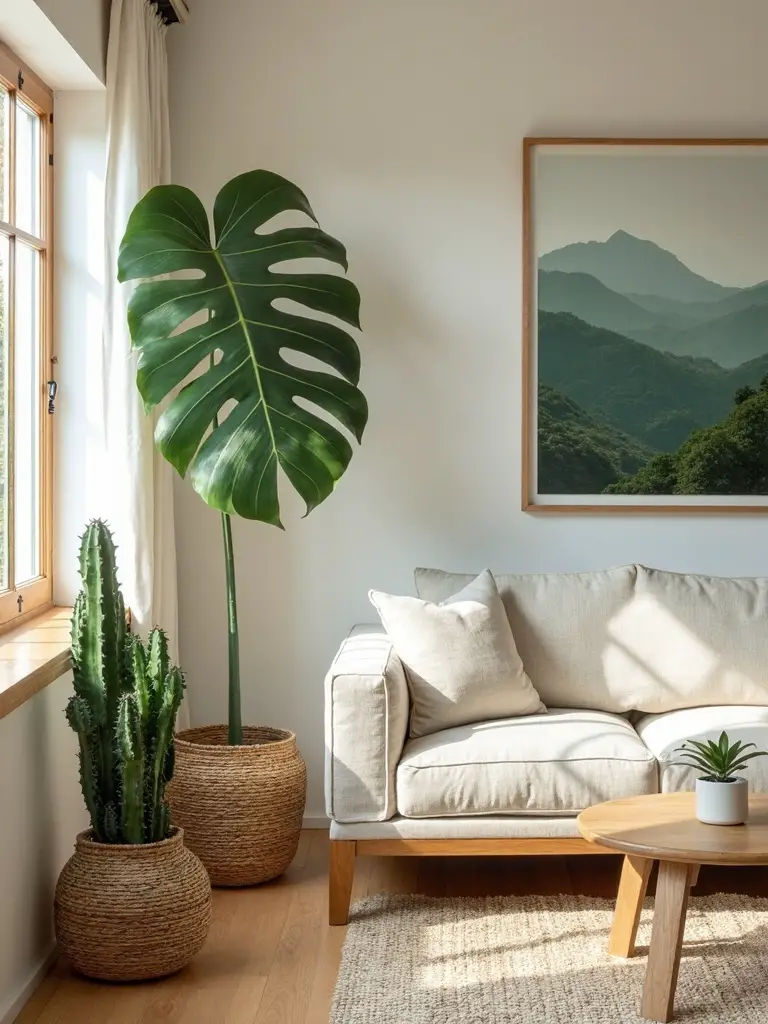
Bringing nature indoors through carefully selected plants alters your Japandi living room into a breathing sanctuary that nurtures both body and mind.
Strategic indoor plant placement creates a biophilic atmosphere that seamlessly connects your space to the natural world. Position snake plants and pothos in corners to soften minimalist lines while adding smaller specimens on shelves for visual interest.
Choose natural-toned planters in terracotta or concrete that complement your neutral palette. Low-maintenance varieties like ferns purify air while reinforcing Japandi’s functional philosophy.
These living elements introduce natural beauty without overwhelming your carefully curated aesthetic.
Hidden Functional Storage Solutions
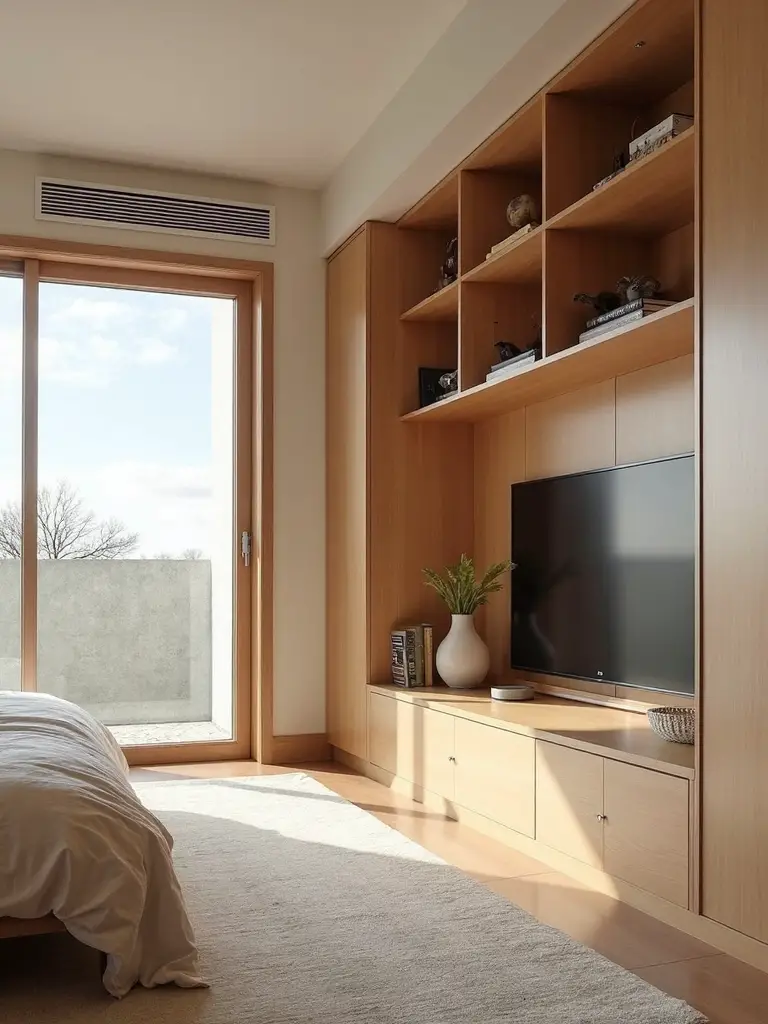
Clutter disrupts the serene harmony that makes Japandi design so appealing, making smart storage solutions your secret weapon for maintaining visual calm. Built-in cabinets seamlessly blend into walls, concealing books and media equipment without breaking clean lines.
Choose multifunctional furniture like ottomans with hidden compartments that serve dual purposes in neutral living spaces. Streamlined media consoles with sliding doors maintain the aesthetic while hiding electronics. Floating shelves maximize vertical space for displaying carefully curated items.
Smart cable management keeps unsightly cords hidden, preserving the tranquil atmosphere essential to Japandi furniture and decor philosophy.
Warm White and Cream Paint Palette
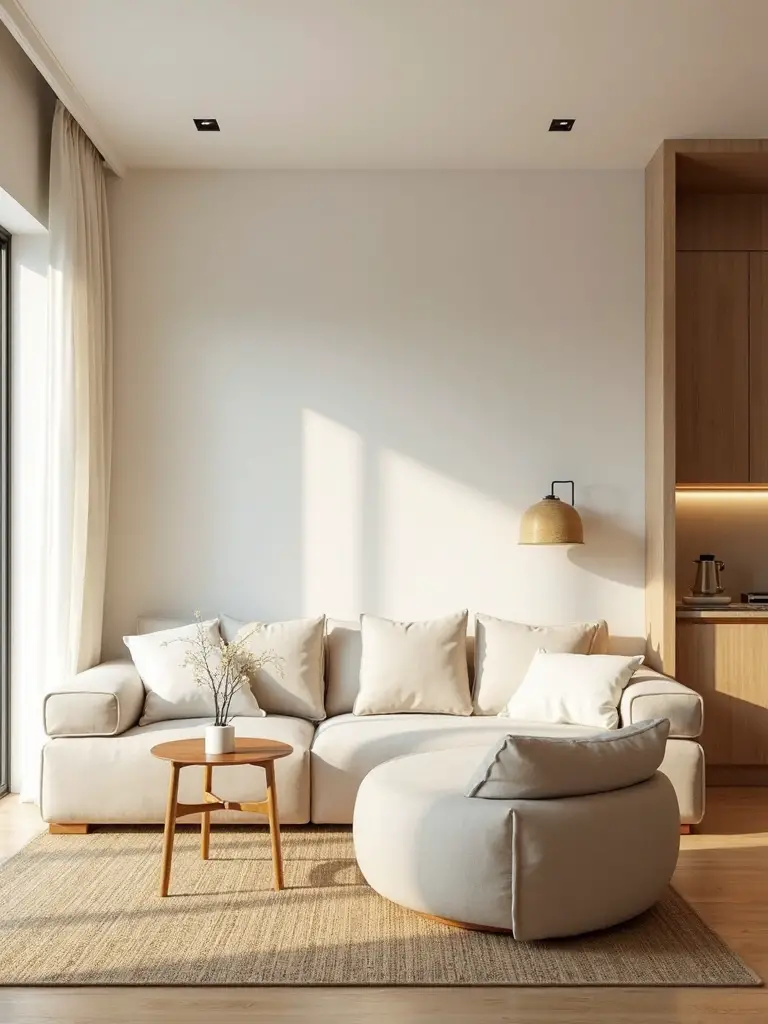
Soft, warm whites and cream tones create the perfect foundation for your Japandi living room’s peaceful atmosphere. These neutral colors work together to establish calming visual harmony while maintaining the style’s essential simplicity. Choose muted tones like warm ivory, soft pearl, or gentle eggshell to create a warm, embracing environment.
Apply these shades strategically across walls, trim, and ceiling to establish seamless flow throughout your space. The subtle variations between whites and creams add depth without overwhelming the senses. This thoughtful color approach helps create an inviting atmosphere that perfectly balances Scandinavian brightness with Japanese tranquility and understated elegance.
Rattan and Bamboo Accent Elements
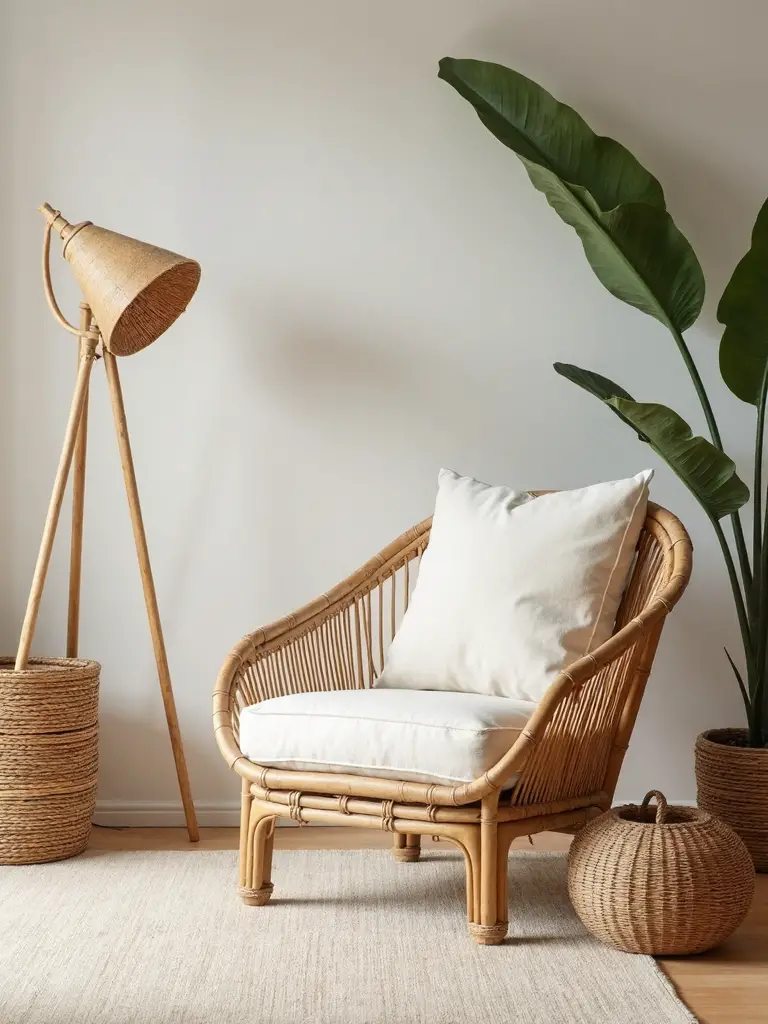
Natural rattan and bamboo elements alter your Japandi living room by introducing organic textures that bridge the gap between Scandinavian comfort and Japanese minimalism. These natural materials create warmth without overwhelming your space’s clean aesthetic.
Install bamboo blinds or screens to filter sunlight while maintaining privacy and airiness. Choose rattan armchairs or coffee tables that provide earthy comfort alongside your minimalist furniture. Display sculptural bamboo vases as accent pieces that celebrate sustainable design principles.
Add a rattan pendant light to cast soft, diffused illumination throughout your room. Incorporate woven baskets for stylish storage solutions that enhance natural texture.
Floor Cushion Meditation Corner
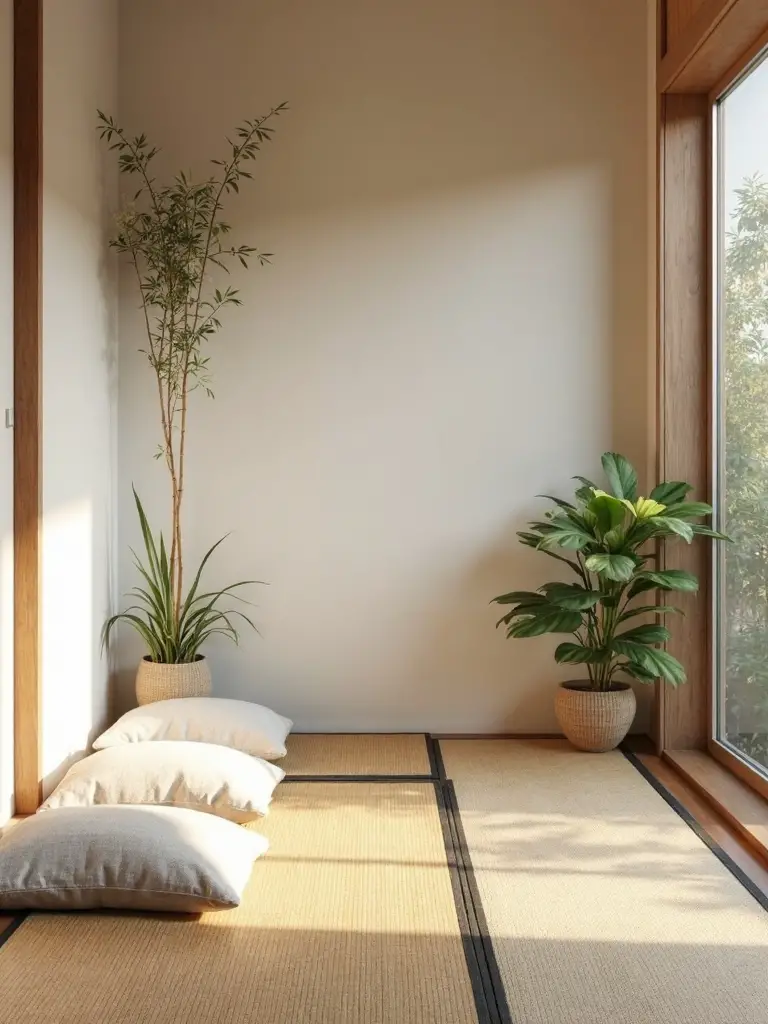
Building on the natural warmth that rattan and bamboo elements bring to your space, you can establish a dedicated floor cushion meditation corner that embodies the peaceful essence of Japanese living.
Position traditional Japanese zabuton cushions around a low table crafted from natural materials like wood near your window. This placement maximizes natural light while creating an intimate sanctuary that blends Japanese minimalism and Scandinavian functionality.
Complete your corner with hemp or linen cushions, a ceramic incense holder, and soft paper lantern lighting to maintain the zen atmosphere essential for mindful contemplation.
Natural Stone and Ceramic Features
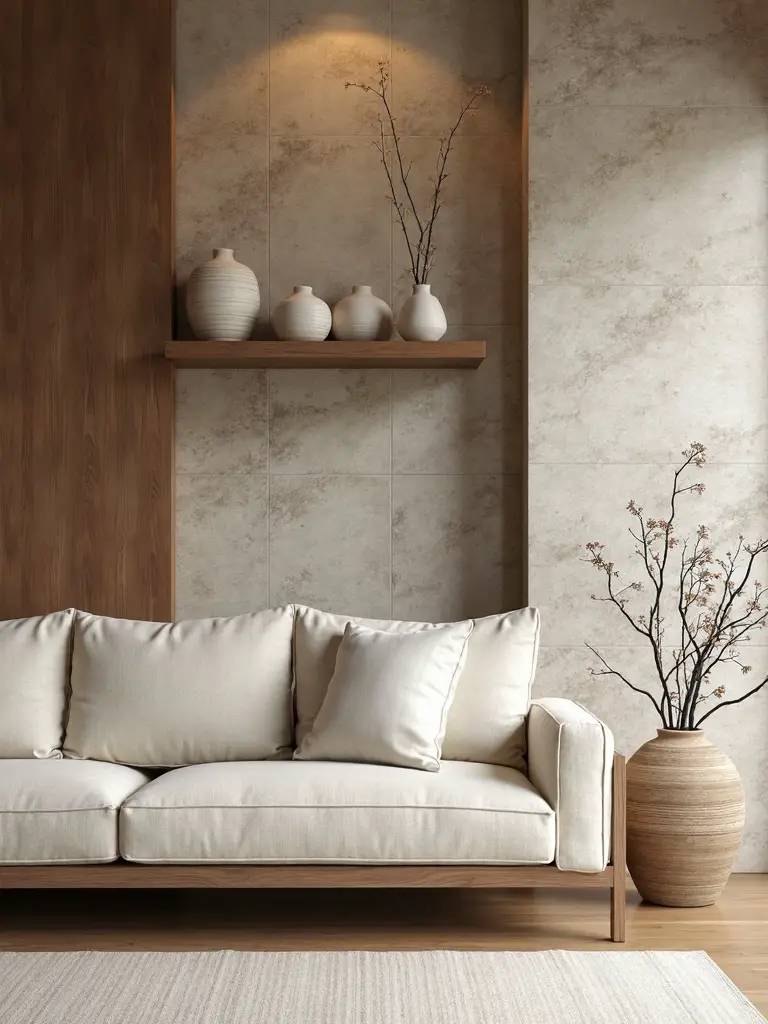
When you introduce natural stone and ceramic elements into your Japandi living room, you’ll create striking focal points that balance the space’s warm wooden textures. A marble or limestone coffee table provides cool contrast while grounding your seating area beautifully.
Add handcrafted ceramic vases and bowls to celebrate imperfect artisanal beauty that defines this aesthetic. Consider installing textured tiles on your fireplace surround for subtle visual interest without disrupting minimalist harmony. Pair a stone mantel with wood-framed mirrors to blend Japanese and Scandinavian influences seamlessly.
Complete the look with smooth terracotta planters that house your favorite indoor plants.
Abstract Monochrome Wall Art Display
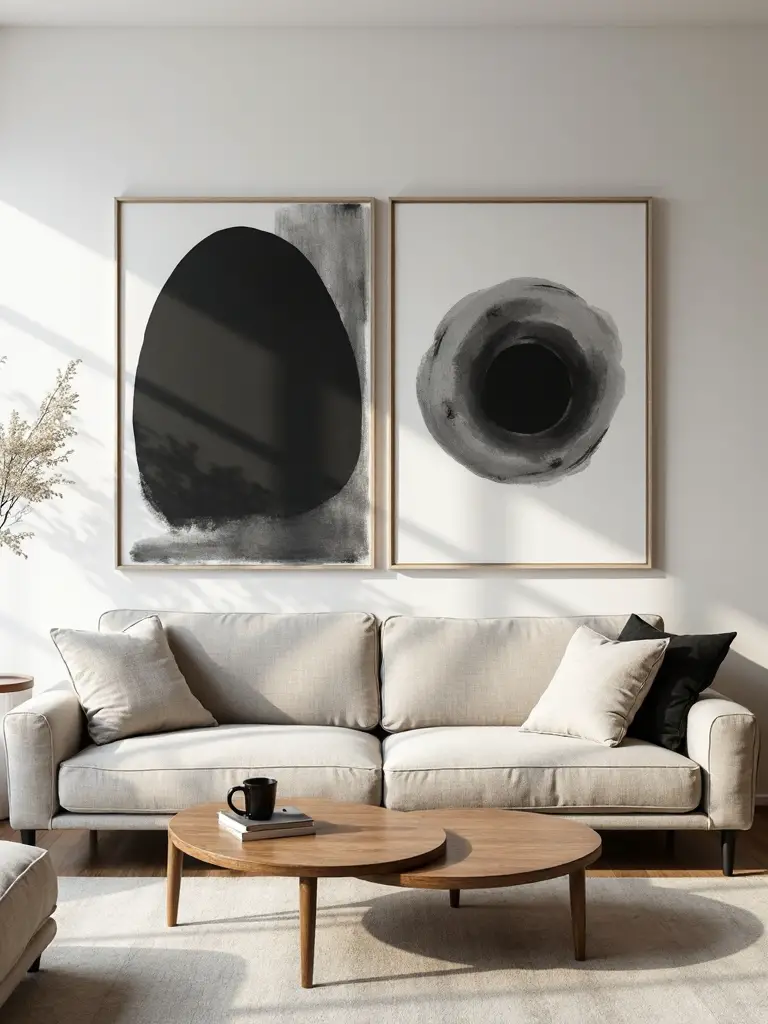
Something magical happens when you carefully curate abstract monochrome wall art that speaks to both Japanese wabi-sabi and Scandinavian lagom principles. You’ll find that minimalist art featuring black and white photography or delicate line drawings creates perfect focal points without overwhelming your space.
Consider incorporating Japanese calligraphy pieces alongside nature-inspired prints to honor both cultural aesthetics. Frame each piece using consistent neutral materials like natural wood or simple black frames. Leave generous white space around your monochrome wall art to let each piece breathe and contribute to your room’s serene atmosphere.
Wooden Slat Room Dividers
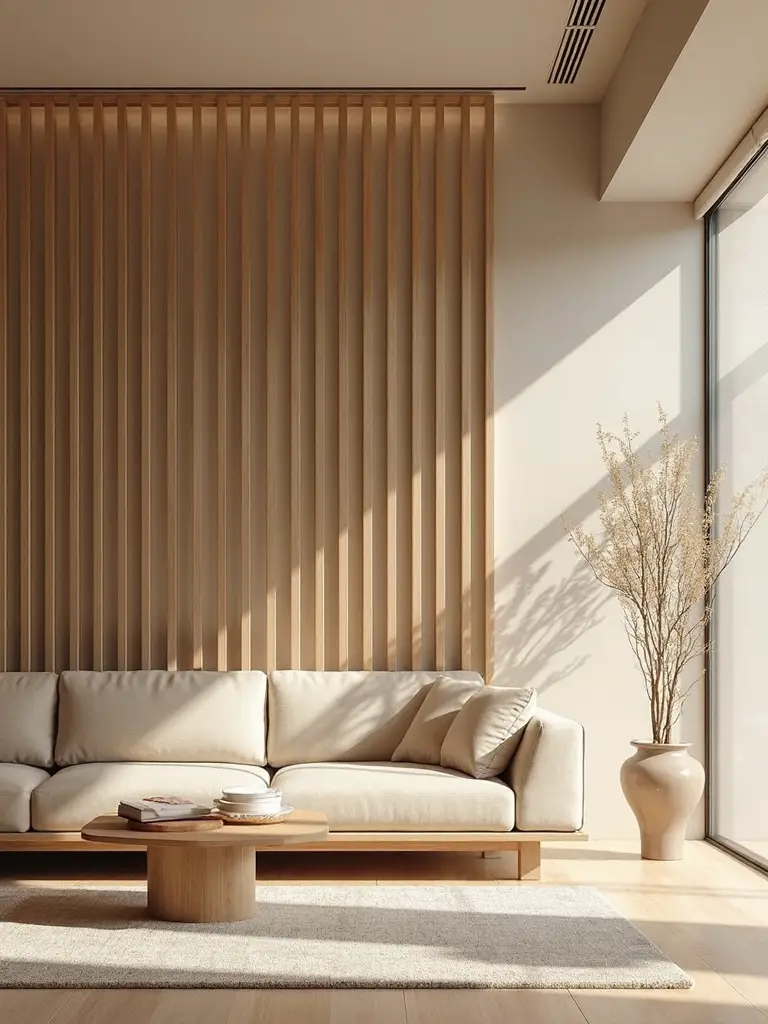
Wooden slat room dividers bring an effortless elegance to your Japandi living room while maintaining the open, airy feel that defines this design philosophy. These versatile elements create visual interest through their clean, linear patterns while defining distinct zones without blocking precious natural light.
Choose vertically arranged slats in light oak or ash tones to add warmth and texture to your minimalist space. Consider integrating LED backlighting behind the wood panels to enhance the cozy ambiance and highlight the natural grain.
This functional approach perfectly balances the Japanese concept of ma with Scandinavian simplicity.
Cozy Reading Nook With Soft Textiles
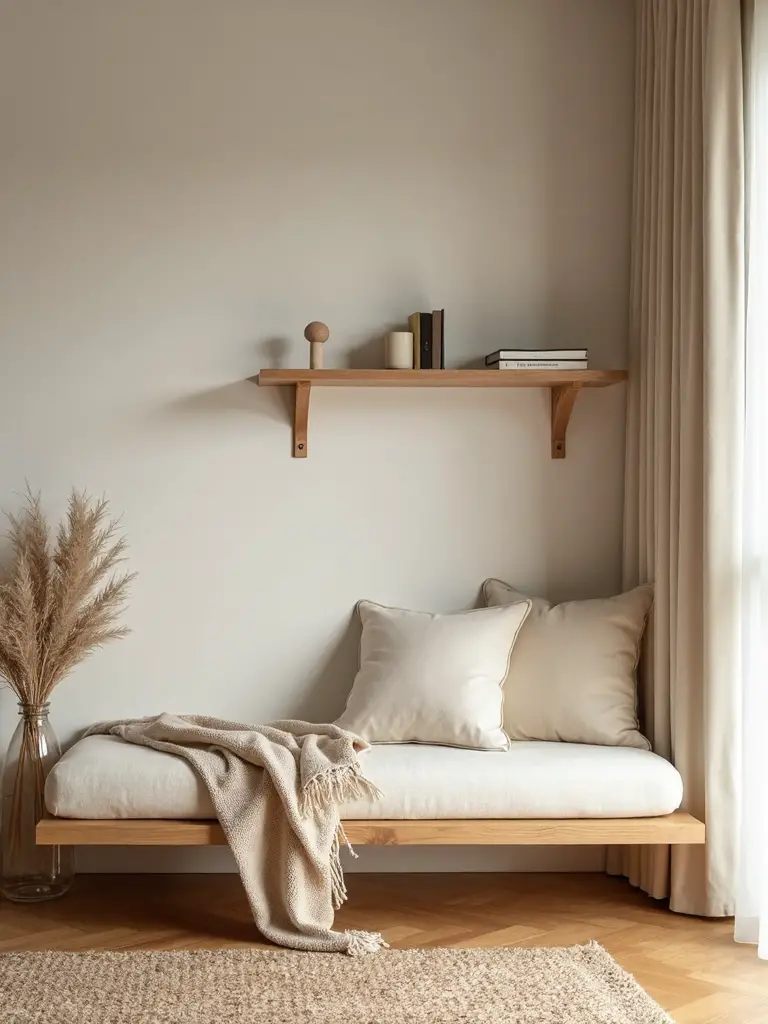
Although Japandi design celebrates minimalism, a thoughtfully curated reading nook alters your living room into a sanctuary where comfort meets understated elegance.
Position an oversized armchair upholstered in natural linen near your largest window to maximize daylight exposure. Layer plush throw pillows in earthy tones that complement your existing wood tones throughout the living space. Add a lightweight blanket for instant coziness during reading sessions. Include a small side table to hold essentials like books and beverages. Complete your nook with a wooden floor lamp that provides adjustable soft lighting for comfortable evening reading while maintaining the serene aesthetic.
Floating Shelves With Curated Objects
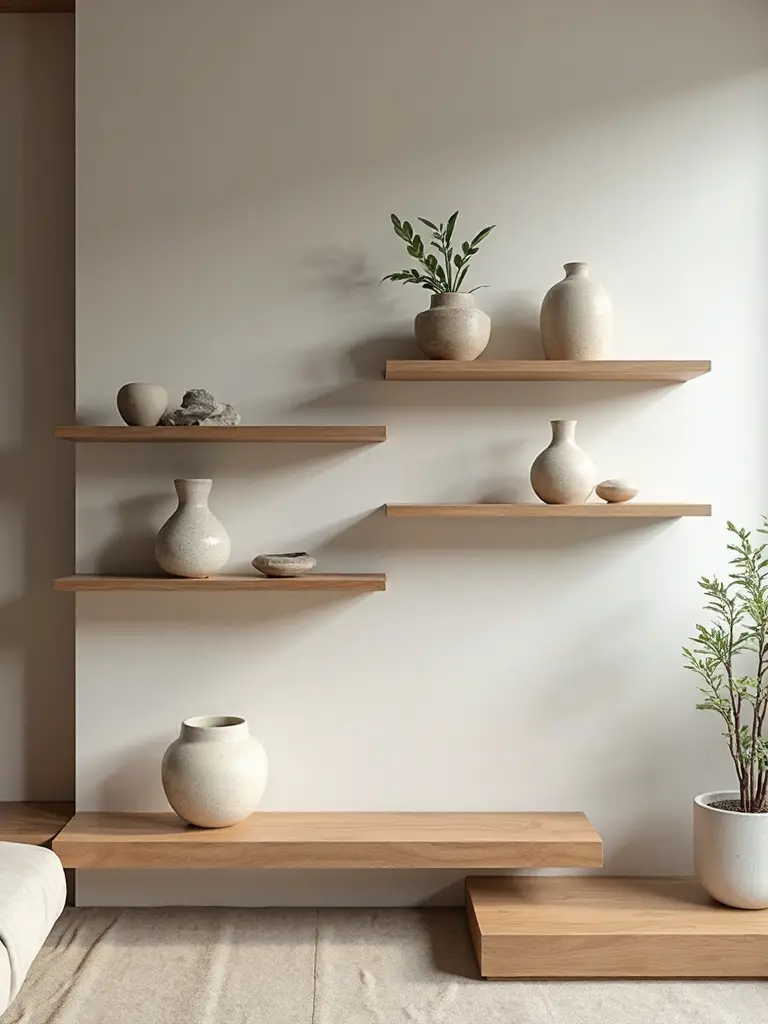
Since visual clutter disrupts the peaceful atmosphere that defines Japandi interiors, floating shelves offer a graceful solution for displaying meaningful objects without overwhelming your space. These streamlined shelves showcase the natural beauty of wood grain while maintaining the clean lines essential to minimalism.
Your thoughtfully curated selection should include ceramics, small plants, and artwork in neutral tones that embody the Japandi aesthetic. Arrange these objects asymmetrically to create visual interest and balance. The floating design maximizes vertical space while preserving an airy feel, allowing light and shadow to add depth and dynamism to your living room’s overall design.
Earthy Accent Colors in Muted Tones
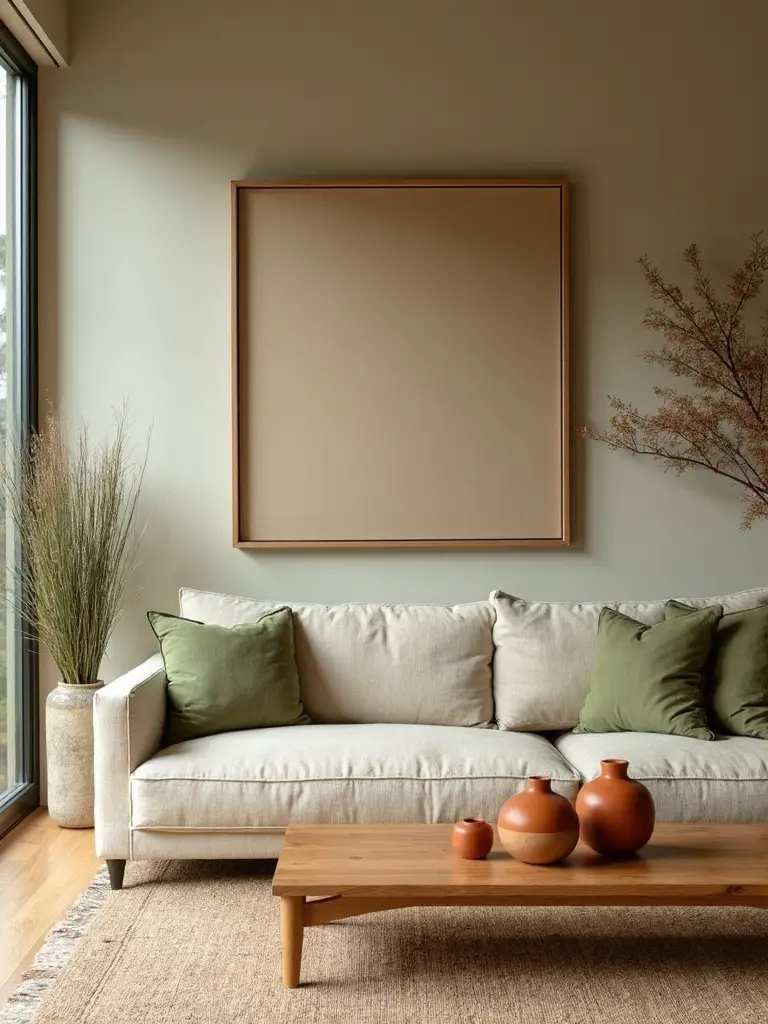
While bold colors can energize a space, muted earthy tones create the serene foundation that makes Japandi living rooms feel like peaceful retreats. Choose neutral base colors like warm beige, soft sage green, or dusty terracotta to maintain tranquility while adding visual interest.
These earth tones work harmoniously with natural wood and stone elements typical in Japandi design. You can introduce a subtle pop of color through muted rust-orange cushions or pale blue ceramics without overwhelming the space. This restrained color palette creates an aesthetically pleasing environment that promotes relaxation and mindfulness in your modern living room.
Organic Shape Coffee Tables and Poufs
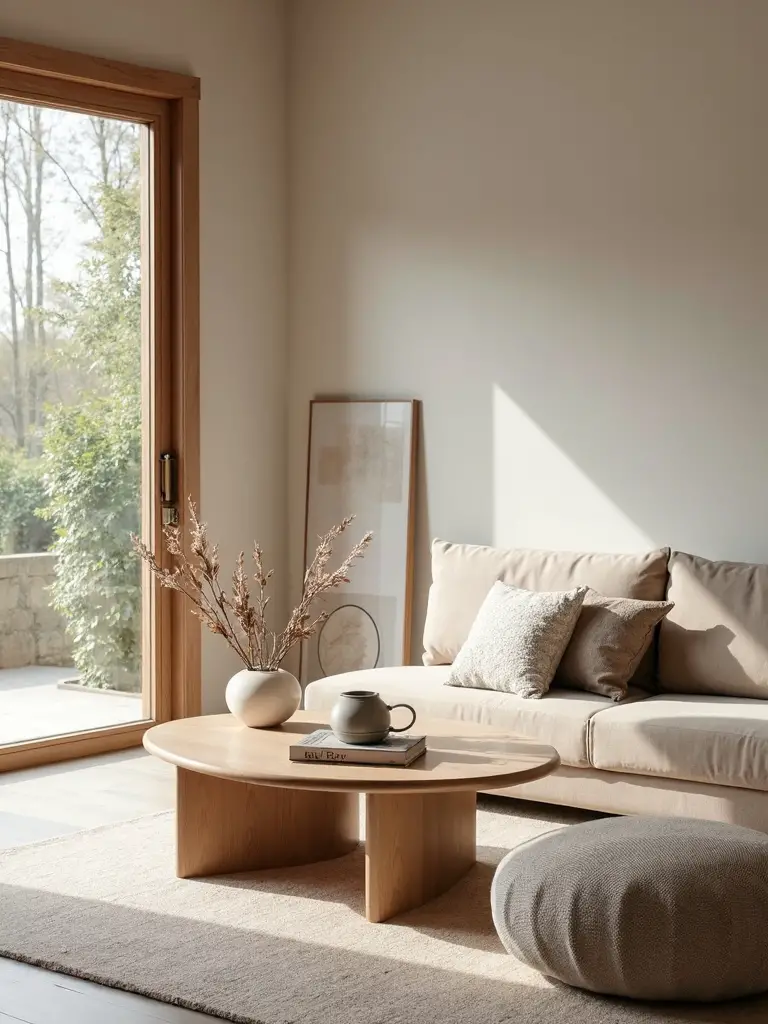
When you introduce organic-shaped coffee tables and poufs into your Japandi living room, you’ll create a perfect balance between functionality and flowing natural beauty. Choose coffee tables with rounded edges that showcase natural wood grain for a calming, grounded focal point.
Add low-profile poufs in textured fabrics like jute or linen to provide flexible seating while softening angular lines. Combine rectangular wood tables with circular poufs for shape variety that prevents uniformity. Consider sculptural stone pieces with asymmetrical silhouettes for visual interest, or select rattan options that bring warmth and organic texture to complement your clean-lined furnishings.
Tatami-Inspired Flooring Elements
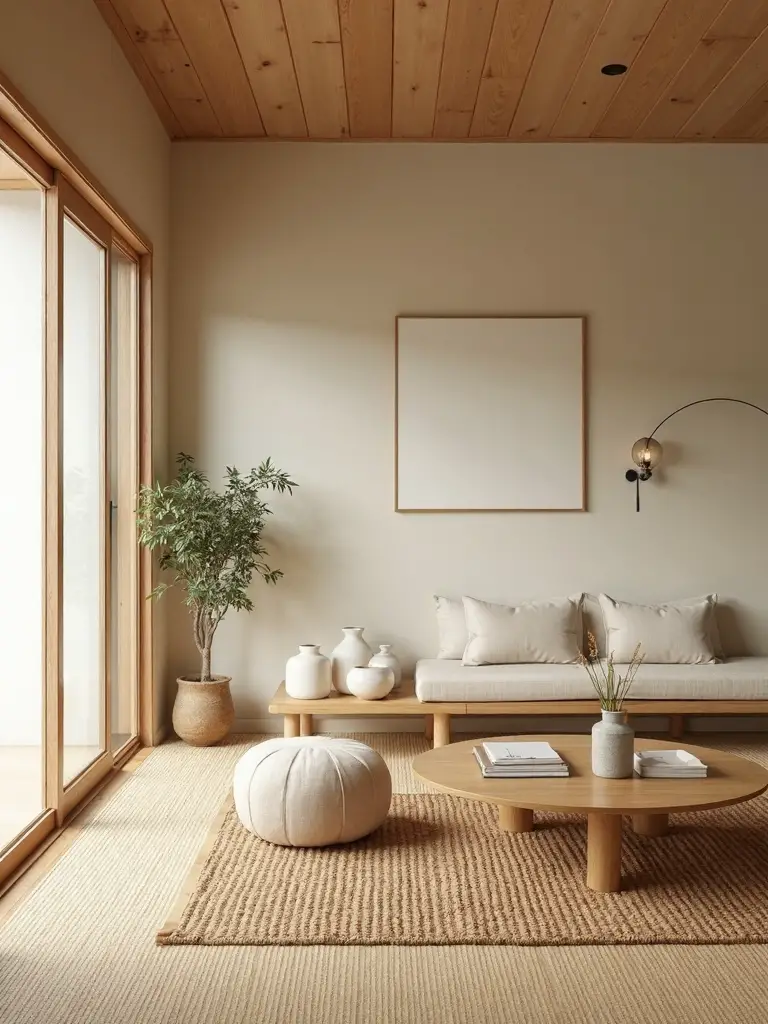
Tatami-inspired flooring elements effortlessly ground your Japandi living room with authentic Japanese warmth while maintaining the clean aesthetic you’re creating. Traditional tatami mats bring woven soft rush textures that connect your space directly to nature’s calming influence.
You can achieve similar effects using light wood flooring with uniform finishes that create meditative atmospheres without restricting furniture placement. Raised platforms establish dedicated relaxing zones within your open layout, while natural fiber area rugs add visual warmth to existing floors.
Consider incorporating minimalist patterns through decorative screens or textiles that subtly reference Japanese design principles while preserving your serene, uncluttered environment.
Layered Ambient Lighting With Dimmers
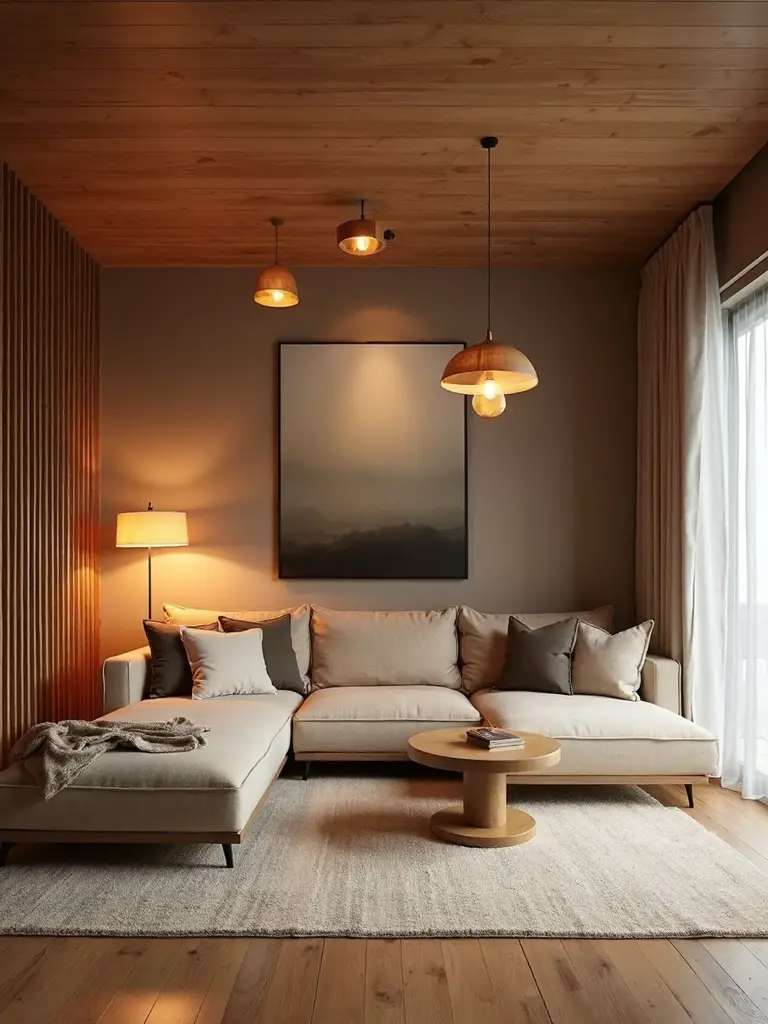
Three distinct lighting layers alter your Japandi living room into a sanctuary that adjusts perfectly to different moods and activities throughout the day. Start with overhead pendant lights featuring natural materials like bamboo or paper shades for general illumination.
Add a sleek floor lamp with warm LED bulbs in corners to create intimate reading nooks. Install dimmable table lamps on low consoles to provide soft accent lighting during evening relaxation. This layered lighting approach lets you control exactly how the room feel shifts from energetic daytime productivity to peaceful nighttime unwinding through simple dimmer adjustments.
Linen and Cotton Window Treatments
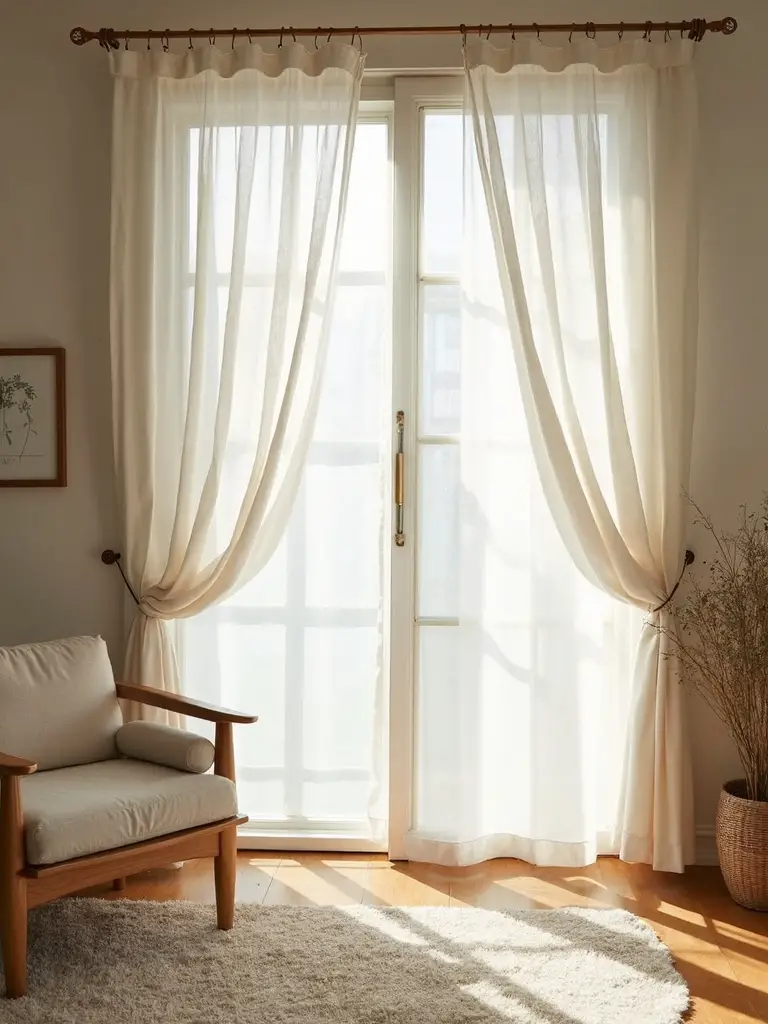
While thoughtful lighting establishes your room’s atmosphere, the right window treatments complete the serene foundation of your Japandi living space. Choose soft linen curtains in neutral tones that filter natural light beautifully while maintaining privacy.
Cotton voile panels in muted blues or greens add subtle color without overwhelming your minimalist aesthetic. Bamboo shades and woven wooden blinds complement light wood furniture perfectly, creating seamless integration with Japandi interior design style. Layer different materials for versatile light control throughout your living area.
Roman shades offer easy operation for adjusting daylight levels while preserving the clean, uncluttered appearance essential to authentic Japanese-Scandinavian design.
Zen-Inspired Corner With Natural Elements
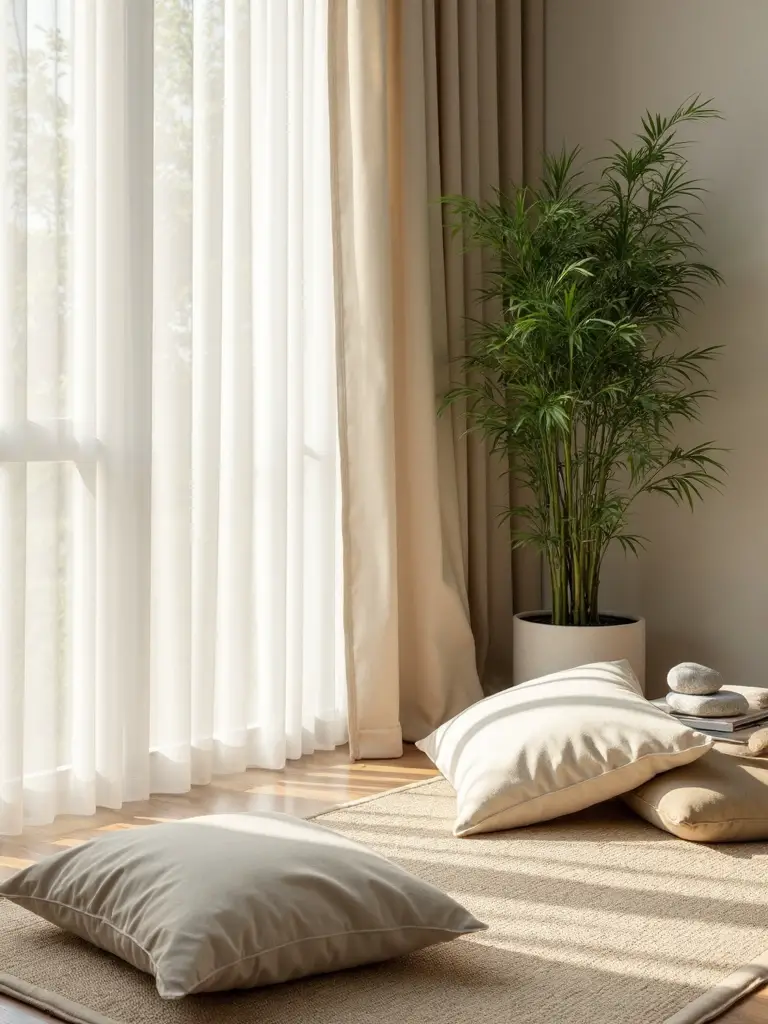
Creating a dedicated zen corner alters any living room into a peaceful sanctuary where natural elements take center stage. You’ll want to select low-profile furniture like a comfortable armchair that doesn’t overwhelm the space.
Natural wood elements such as floating shelves and bamboo accents add organic warmth while maintaining clean lines. Drape linen or cotton throws over seating to enhance comfort and texture.
Position your corner near windows where soft light filters through, then add a simple side table with fresh greenery. These minimalist elements work together, creating visual calm that promotes mindfulness and mental clarity.
Conclusion
You’ve uncovered how Japandi design metamorphoses your living space into a peaceful retreat through natural materials, warm lighting, and mindful arrangements. Begin with one element like a wood accent wall or floor seating, then gradually layer in neutral textiles and ambient lighting. Remember, this style lauds imperfection and simplicity, so don’t overthink each choice. Trust your instincts, accept natural beauty, and create the serene sanctuary you deserve.
